Overview
Discover the fundamentals of Java programming with this Java tutorial for beginners. In this tutorial, we will cover the fundamentals of Java and the types of applications that can be developed with this language with various Java examples.
This comprehensive guide will also cover the different Java platforms or editions to help you become a proficient Java developer.
What is Java?
Java is a widely used, high-level, object-oriented programming language developed by Sun Microsystems (now owned by Oracle) in the mid-1990s. It is designed to be platform-independent, allowing programs written in Java to run on any system with a Java Virtual Machine (JVM) installed. This "Write Once, Run Anywhere" (WORA) principle makes Java highly versatile.
Java also bears a similarity in syntax to the C and C++ programming languages. This, in turn, makes a Java tutorial for beginners easy to master for programmers familiar with these languages. The interface is known for its simplicity, readability, and robustness. Java's object-oriented nature allows for modular and reusable code, making it ideal for building complex applications.
One of Java's key features is its automatic memory management through garbage collection, which helps developers avoid memory leaks and ensures efficient memory usage. Additionally, Java offers a rich set of libraries and frameworks that simplify tasks such as network programming, database access, and graphical user interface (GUI) development.
Java is widely used in various domains, including enterprise software development, web development, mobile app development (with Android), scientific research, and more. Its popularity stems from its stability, portability, and extensive community support, making it an excellent choice for beginner and experienced programmers.
Types of Java Applications
Let us check a few common types of Java applications to understand how this programming language can be used in various ways.
Console-Based Applications
Here is a simple console-based Java example that prints "Hello, World!" to the console when executed:
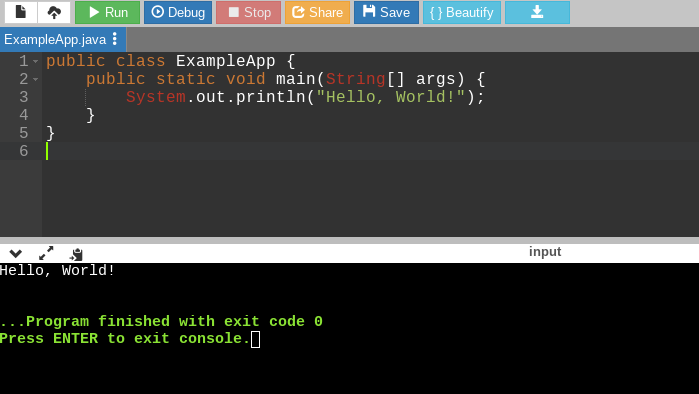
The provided code snippet represents a basic Java console application. It defines a public class named ExampleApp with a main method as the entry point.
The main method is the starting point of the program and is declared with public static void main() and takes an array of strings (String[] args) as a parameter, representing command-line arguments.
Within the main method, the statement System.out.println("Hello, World!"); is used to display the string "Hello, World!" as output on the console. This code demonstrates the fundamental structure of a console application and illustrates how to print text to the console using the System.out.println() method.
GUI Applications
Here is a basic Java GUI application using Swing that creates a window with a button displaying "Click Me" when executed:
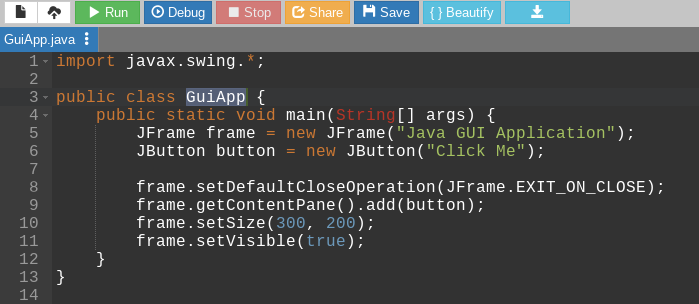
The code defines a class named GuiApp with a main method. It creates an instance of JFrame to represent a window and adds a JButton. The window's title is set, and its size and visibility are also configured.
Web Applications (Servlet-based)
Here is an example that shows a simple Java servlet that responds with an HTML page containing the text "Hello, World!" when accessed:

The code showcases a class named HelloServlet that extends HttpServlet. It overrides the doGet method to handle HTTP GET requests. It sets the response content type to HTML and writes an HTML response containing the message "Hello, World!". This code presents a basic Java servlet for generating dynamic web content.

Desktop Applications
Here is an example that demonstrates a JavaFX desktop application. It creates a window with a label displaying "Hello, World!" when executed:
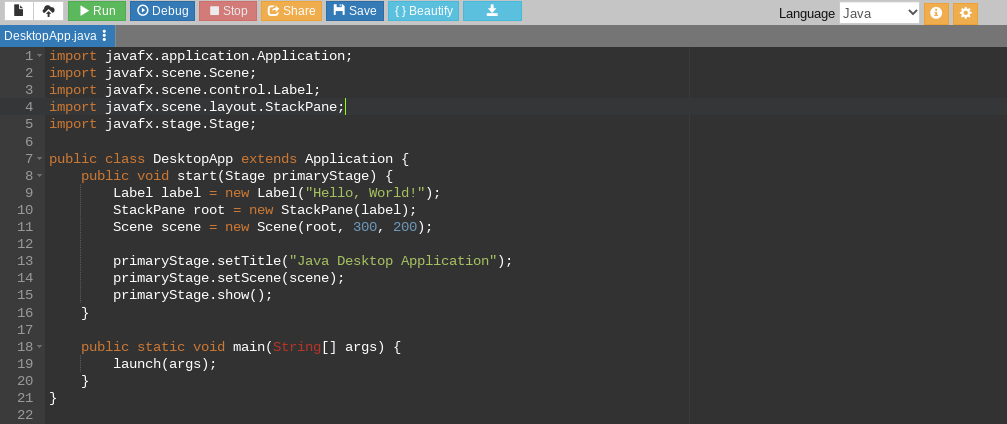
The code demonstrates a JavaFX desktop application. It extends the Application class, overriding the start method to configure the user interface. It creates a window with a "Hello, World!" label. The application's title, scene, and stage are set, and the window is displayed.
Mobile Applications
Here is a code snippet from an Android application that sets the content view to a TextView displaying "Hello, World!" on the screen:
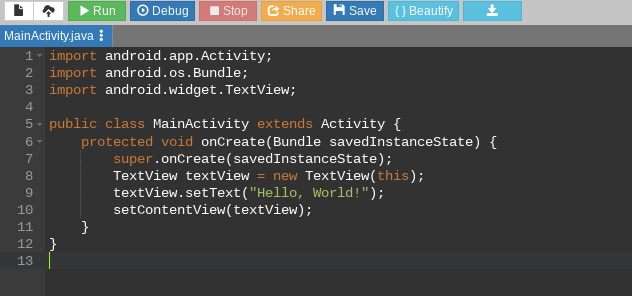
The code showcases an Android application's main activity, MainActivity. It extends the Activity class, overriding the onCreate method to configure the user interface. It creates a TextView and sets its text to "Hello, World!". The TextView is set as the content view of the activity.
Database Applications (JDBC)
Here is an example that demonstrates a basic Java database application using JDBC (Java Database Connectivity). This program establishes a connection to a MySQL database, executes a query, and retrieves data from the result set:
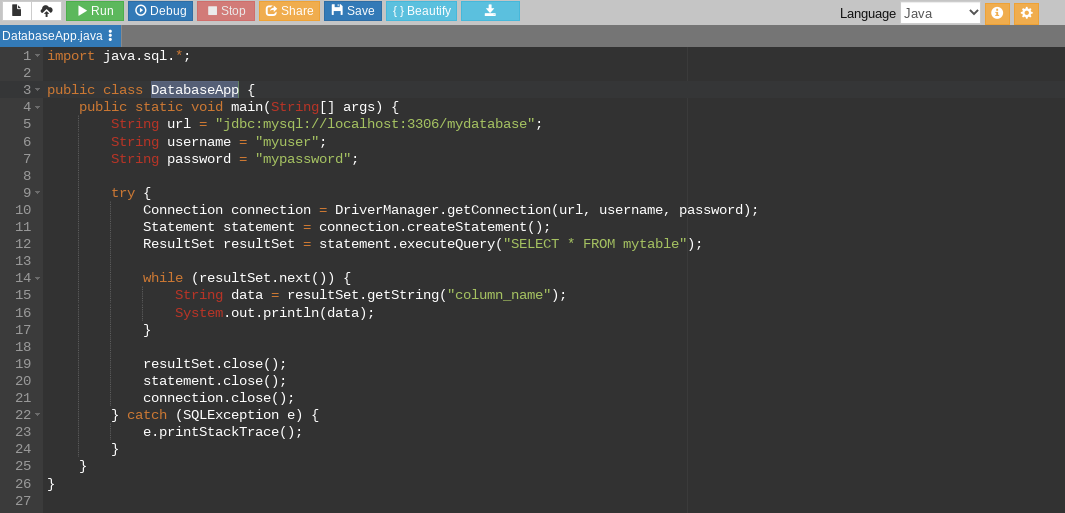
Multithreaded Applications
Here is an example that demonstrates a multithreaded Java application:
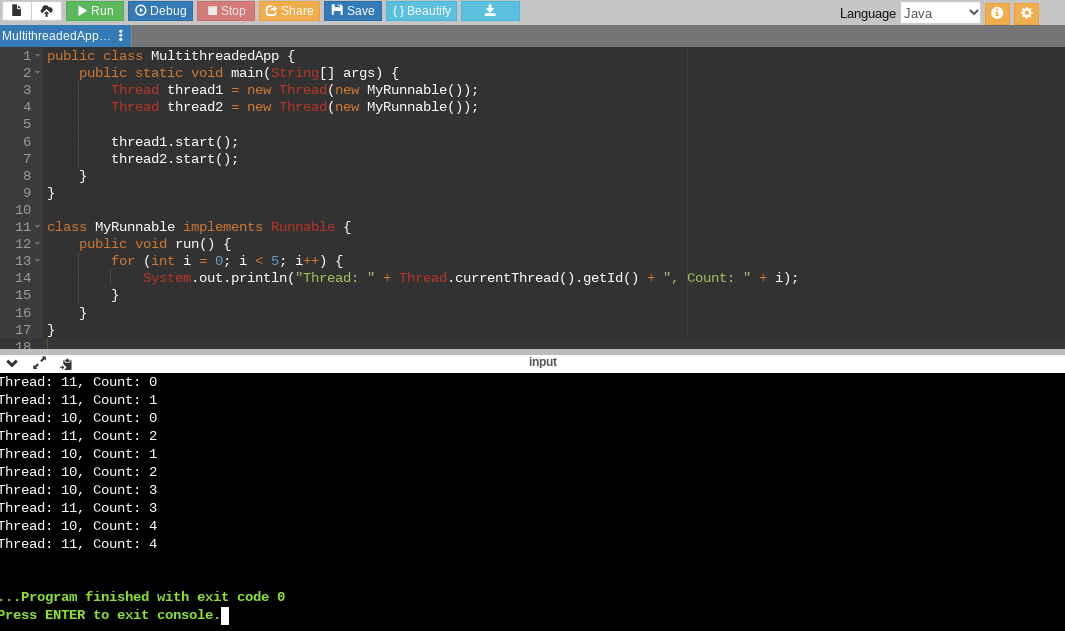
In the MultithreadedApp class, the main method serves as the entry point of the program. It creates two threads, thread1 and thread2, by passing instances of the MyRunnable class to the Thread constructor. This allows the threads to execute the run method defined in MyRunnable.
The MyRunnable class implements the Runnable interface, which requires implementing the run method. Within the run method, a loop is executed five times. In each iteration, the method prints a message that includes the thread ID (obtained using Thread.currentThread().getId()) and a count value.
Both threads start with the start method when the program is run. As a result, the run method of each thread is executed concurrently. This leads to the interleaved printing of messages from different threads, each with its unique ID.
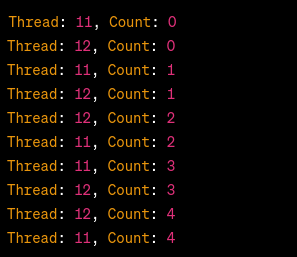
The program's output may vary on each run, but it typically displays the thread ID and count values interleaved. This demonstrates the concurrent execution of multiple threads in a multithreaded application.
Code:
public class MultithreadedApp {
public static void main(String[] args) {
Thread thread1 = new Thread(new MyRunnable());
Thread thread2 = new Thread(new MyRunnable());
thread1.start();
thread2.start();
}
}
class MyRunnable implements Runnable {
public void run() {
for (int i = 0; i < 5; i++) {
System.out.println("Thread: " + Thread.currentThread().getId() + ", Count: " + i);
}
}
}Network Applications (Server-Client)
Here is a Java example that showcases a basic client-server network application:
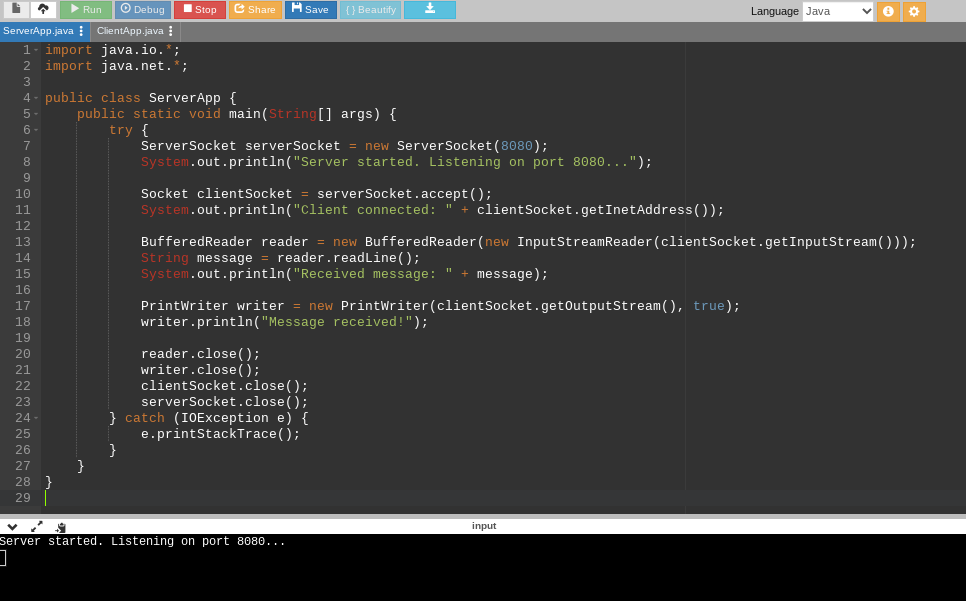
(ServerApp.java file)
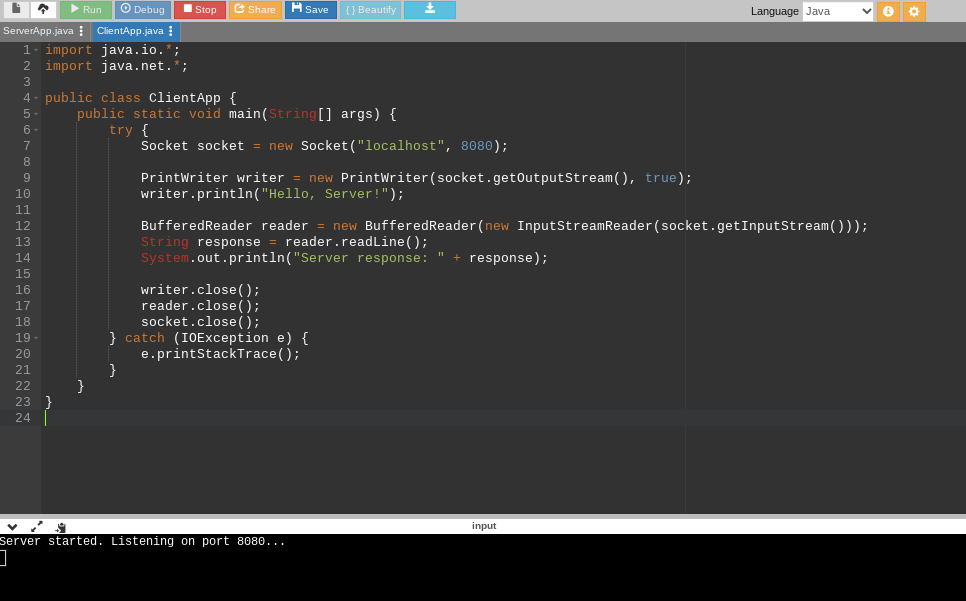
(ClientApp.java file)
The ServerApp class represents a server-side application. It creates a ServerSocket to listen on port 8080 for incoming client connections. When a client connects, the server accepts the connection and reads the client's message using a BufferedReader. It then prints the received message and responds to the client using a PrintWriter. Finally, it closes the reader, writer, client, and server sockets.
The ClientApp class represents a client-side application. It creates a Socket to connect to the server at "localhost" on port 8080. It sends a message to the server using a PrintWriter and reads its response using a BufferedReader. The received response is printed, and then the reader, writer, and socket are closed.
Code for the ServerApp.java file:
import java.io.*;
import java.net.*;
public class ServerApp {
public static void main(String[] args) {
try {
ServerSocket serverSocket = new ServerSocket(8080);
System.out.println("Server started. Listening on port 8080...");
Socket clientSocket = serverSocket.accept();
System.out.println("Client connected: " + clientSocket.getInetAddress());
BufferedReader reader = new BufferedReader(new InputStreamReader(clientSocket.getInputStream()));
String message = reader.readLine();
System.out.println("Received message: " + message);
PrintWriter writer = new PrintWriter(clientSocket.getOutputStream(), true);
writer.println("Message received!");
reader.close();
writer.close();
clientSocket.close();
serverSocket.close();
} catch (IOException e) {
e.printStackTrace();
}
}
}
Server Output:

Code for the ClientApp.file:
import java.io.*;
import java.net.*;
public class ClientApp {
public static void main(String[] args) {
try {
Socket socket = new Socket("localhost", 8080);
PrintWriter writer = new PrintWriter(socket.getOutputStream(), true);
writer.println("Hello, Server!");
BufferedReader reader = new BufferedReader(new InputStreamReader(socket.getInputStream()));
String response = reader.readLine();
System.out.println("Server response: " + response);
writer.close();
reader.close();
socket.close();
} catch (IOException e) {
e.printStackTrace();
}
}
}
Client output:

Java offers different platforms or editions, each tailored to meet specific types of Java applications and domains. These platforms provide a range of tools, libraries, and APIs to support developers in their respective focus areas.
1. Java Standard Edition (Java SE):
This edition provides the core components and libraries necessary for general-purpose Java development. It includes features for desktop applications, command-line tools, and server-side applications.
2. Java Enterprise Edition (Java EE):
Java EE is designed for developing large-scale, enterprise-level applications. It extends Java SE by adding additional APIs and frameworks for distributed computing, web services, and enterprise application integration.
3. Java Micro Edition (Java ME):
Java ME is optimized for resource-constrained devices, such as mobile phones, embedded systems, and IoT devices. It offers a subset of Java SE functionality to accommodate the limitations of these devices.
4. JavaFX:
JavaFX is a platform for building rich, cross-platform desktop applications with modern user interfaces. It provides a set of UI controls, multimedia support, and 3D graphics capabilities.
These platforms allow developers to choose the most suitable edition for their project requirements, ensuring flexibility and scalability across various domains and device types.
Conclusion
Whether you're interested in developing desktop applications, enterprise software, mobile apps, or even exploring the Internet of Things (IoT), Java has got you covered. Its WORA capability, extensive libraries, and strong community support make it an excellent choice for beginners and experienced developers.
Learning Java opens up a world of possibilities and provides a solid foundation for a successful career in programming. So, grab your favorite IDE, dive into Java, and prepare to embark on an exciting and rewarding journey. Programming can sometimes be challenging, but with Java, you have a powerful tool to bring your ideas to life. Happy coding!
FAQs
1. Is Java difficult to learn for beginners?
Java can be challenging for beginners due to its syntax and object-oriented nature. However, with proper guidance and practice, it is considered one of the more beginner-friendly languages. Its extensive documentation, online resources, and active community make it easier to find help and support while learning.
2. Can I use Java for web development?
Yes, Java is widely used for web development. Java frameworks like Spring and JavaServer Faces (JSF) provide powerful tools for building robust and scalable web applications. Additionally, Java's compatibility with databases and support for server-side technologies make it a popular choice for developing dynamic websites and web services.
3. What is the future of Java?
Java continues to be a popular and in-demand programming language. With its versatility, portability, and wide adoption, the future of Java looks promising. Java's compatibility with emerging technologies like cloud computing, big data, and machine learning ensures its relevance in the ever-evolving tech industry. Additionally, the active Java community and regular updates from Oracle ensure that Java remains up-to-date and equipped to tackle future challenges.
Take the Free Quiz on Java
Answer quick questions and assess your Java knowledge



-7f4b4f34e09d42bfa73b58f4a230cffa.webp&w=128&q=75)
-7f4b4f34e09d42bfa73b58f4a230cffa.webp&w=128&q=75)


























-ae8d039bbd2a41318308f8d26b52ac8f.svg)













-9cd0a42cab014b9e8d6d4c4ba3f27ab1.webp&w=3840&q=75)





